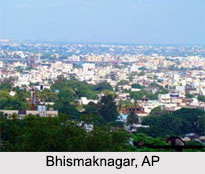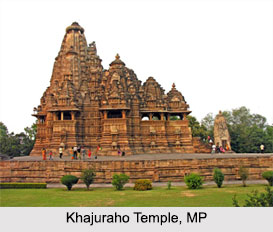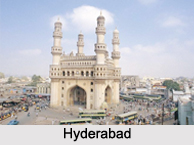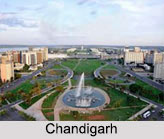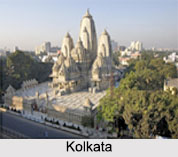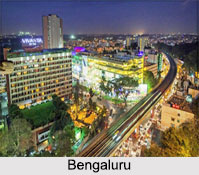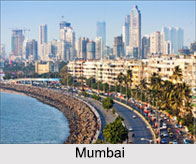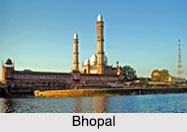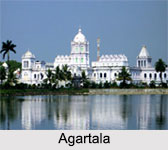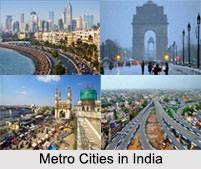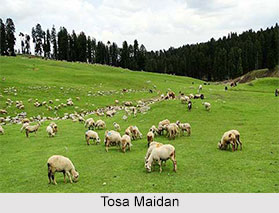 Tourism in Khag covers the nature tourism and leisure tourism to the tourists. Khag has the number of green pastoral fields in the foothills of Pir Panjal Range. Some of the tourist"s attractions are Tosamaidan, Pehjan, Nakwaer Pal, Sita Haran and Pushkar Nag.
Tourism in Khag covers the nature tourism and leisure tourism to the tourists. Khag has the number of green pastoral fields in the foothills of Pir Panjal Range. Some of the tourist"s attractions are Tosamaidan, Pehjan, Nakwaer Pal, Sita Haran and Pushkar Nag.
Tosa Maidan
Tosa Maidan pasture is tourist destination in Khag. It is a large pasture with a historical background. Tosa Maidan is bounded by dense forests of deodars. It is situated about 10km from Khag in the Himalayan Mountain Range in India. Many shepherds used to visit the area in ancient times, and it was a frequent route for Mughals travelling to Poonch district and Punjab in Pakistan. Today the area is frequently used by local shepherds and the Gujjar community. It was occupied by the Indian Army up to the year 2013. After its lease expired it was opened for the public by Government of Jammu and Kashmir with efforts initiated by Omar Abdullah and Saifuddin Soz. The Mughals and British East India Company used to go to Poonch in Poonch District of Jammu and Kashmir using this route. It is said that they had constructed a seven-storeyed building - Dam-Dam - here.
Basmai Gali
Basmai Gali is one of the major attractions in Khag region of Jammu and Kashmir. It is located about 13,000 ft from the sea level. It is the pass which leads into Tosa Maidan.
Poonch Gali
Poonch Gali is located where on its right side leads to the valley of Poonch. This pass was deemed to be the safest, easiest, and nearest to reach Punjab in ancient times. From here, a path also leads to Nilnag. Tosa Maidan is the largest pasture in its surrounding areas, 3 miles in length and 1.5 miles in width. Sky-touching deodars and pinus fence this pasture presenting a view of a green carpet in summer.
Pehjan
Pehjan is an alpine pasture situated about 25 km from Khag in the lap of the Himalayas. The route of the place is from Khag to Gogaldara via Anzwaer. The place is serene, picturesque and rich in deodars covered with various kinds of asters and several plants of Saussuera Lappa (Kuth). To reach this alpine pasture, one has to cross the green slopes of Gogaldara, Donwar, Brari Pather, Anzwaer and Yanga Pather. In local language it is called "Nueer". The place is covered with lush green forest on four sides and in the month of June shepherds from plains of tehsil Beerwah, Magam, Pattan bring their cattle and sheep for grazing. On the way to Pehjan there is a huge rock with Seven Pinus trees on its top which is considered to be the miracle of Sheikh ul Alam Sheikh Noor Din Noorani, besides this other Pinus tree erected on one of the big stone (locally known as Palle Yaeer) is also considered to be his miracle.
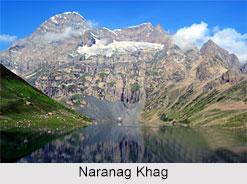 Nakwaer Pal
Nakwaer Pal
On the way to alpine pasture Pehjan, there is the 14,000 ft-high Nakwaer Pal on the way. It is the highest peak of this range. About this rock it is said that when the Kashmir Valley was a lake (Sati Sar), boats used to be anchored with this rock. Today there is an iron hook within it. (Ded Bal), also known as (Lal Khanen Gher) the Place of Lal Khan on the way to Pehjan. Here shepherds and Gujjars come from adjacent villages with their livestock.
Naranag Khag
Naranag Khag is a spring situated in Bus stand Khag. Naranag spring is also known as Narain Nag. The spring is known for its fishes and a fisheries farm has been built by the fisheries department of Jammu and Kashmir. The water of the spring remains very cool during summer and warm during winter.
Tosa Maidan Spring
Tosa Maidan Spring is considered to be the origin of the spring, which according to locals merges with Nara Nag only after flowing various kilometres below the soil. According to local legend, an ascetic passing through Tosa Maidan spring once dropped a bag full of sheep dung into the lake. When he reached Naranag Khag several days later, he saw the dung floating on the surface of the Naranag. He returned to Tosa Maidan and sprinkled some turmeric powder into the lake, which appeared in the water in the Naranag.
Sita Haran
Sita Haran is also known for its spring. Sitaharan is located near Tosa Maidan and the Line of Actual Control for India and Pakistan. According to local legend (Vanvas), Ram Chandra or Lord Rama stayed here during his 12-year-long exile with Lakshman and Sita. The spring`s name comes from Sita who is said to have bathed in the spring. The name got later changed to Sut Haran. Close to the spring is a rock which, according to the legend, was used by Sita to sit on. The spring is also said to be the origin of a small lake, Tosa Maidan. The water of the spring is very sweet.
Pushkar Nag
Pushkar Nag is located to the east of Pushkar village some 15 km from Khag between Khag and Ferozpora, and is named for the village of its origin. According to local history, during the month of Sawan, Kashmiri Pandits would offer prayers and take a ritual dip in the spring. Some devotees continue to perform the ritual today.
Gandhak Nag
Gandhak Nag is a sulphur spring in the Drung Khaipora village of Khag. The healing properties of the sulphur make the spring locally significant.
Pushkar
Pushkar is a village 4 km from Khag, known for its eccentric beauty, offers the tourists for the pastoral beauty.
Related Articles
Cities of Jammu and Kashmir
Jammu and Kashmir
Culture of Jammu and Kashmir
Costumes of Jammu and Kashmir
Early History of Kashmir Valley
Kashmir, India
Kashmir Valley
